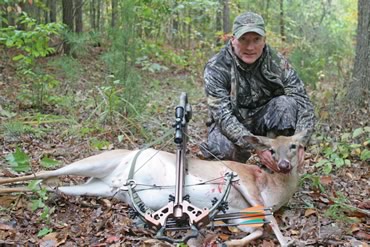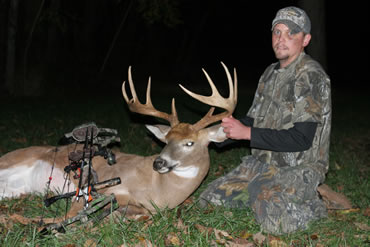Follow this expert tracker’s advice to increase your recovery rate.
As a guide and operations manager for Hadley Creek Outfitters, part of Jared Heller’s job entails finding bucks shot by his hunters. In the 13 years he’s worked for the Illinois outfitter, Heller has tracked hundreds of deer. While most of them are easy to find, some, particularly gut-shot deer, aren’t. But even when he’s searching for a buck that was hit too far back, there’s a good chance — a very good chance — Heller will find it.
“We probably find 98 percent of all the deer that are gut-shot by our hunters,” he says.
RULE NUMBER 1
That might seem like an incredibly high recovery rate. In fact, it far exceeds the numbers put forth in various studies that looked at wounding rates by bowhunters.
One study tallied deer lost to recurve and longbow hunters on an Oklahoma Army base. Just half the deer were recovered. A different study in Maryland looked at recovery rates of compound and crossbow hunters who found 82 percent of their deer.
Heller’s success in finding wounded deer hinges on a single ingredient: time.
Instead of jumping on a blood trail right away, he prefers to wait and allow a wounded deer to lie down and die.
“Don’t get down and look for your arrow or blood, even if you shot it with a gun,” Heller says. “Unless you see the deer lying on the ground dead, stay in your tree and wait. Every time I hear one of my hunters say, ‘I’m just going to go look for blood,’ I tell him not to. I know it’s hard to stay in your stand after you just shot a big buck, but there is nothing more important than giving that deer time.”
How much time? The general rule most hunters follow is anywhere from 30 to 45 minutes, although many hunters can’t resist the urge to find blood right away. When they find it, they often look a little more and then maybe a little more. That’s a sure way to lose a deer.
Unless the animal was shot through the heart or lungs with a firearm, a half-hour is nowhere near long enough.
Heller tells his hunters to climb down and take a nap if they can’t see the deer. He doesn’t even want them to walk out of the woods to the pick-up point. That could bump a buck that circled and bedded down between the treestand and the road. Deer rarely do that, he admits, but it has happened.
 BUMP AND RUN
BUMP AND RUN
“I want to give a deer time to go lay down, no matter how good the shot was,” Heller said. “If he’s dead, he’s not going anywhere. If he’s not, there’s a real good chance you’ll bump him if you start poking around looking for blood.”
A bumped deer, whether shot through the guts or even through one lung, is usually an unrecovered deer. In many instances, deer don’t even know they are hit and will trot off and then stop and lie down. Even deer that were spooked at the shot will often stop just 100 or 200 yards away and then lay down.
Push them once, however, and they get a jolt of adrenaline and take off. That’s why Heller waits up to four hours before he starts looking for blood. If he’s certain the shot was too far back, he’ll wait 12 hours. That lengthy wait might seem unnecessary, but that’s exactly why he recovers most gut-shot deer.
“I almost always find them dead within 150 yards if they are left alone, even gut-shot deer,” he says. “The blood trails are always the same. I’ll find where it stood in one place for a while and then where it bedded down and then got up and bedded down again a few yards away. A lot of times, I find them curled up as if they died while they were lying down.”
THE OTHER 2 PERCENT
Even if all the rules are followed, deer can sometimes get away. It’s an unfortunate but realistic part of deer hunting. If a wounded deer travels more than 200 yards or goes up a steep hill after it was shot, the odds of finding it drop precipitously, even if it wasn’t pushed too soon, Heller says. There could be a simple reason: The wound was superficial and did not damage any organs. Brisket shots or those that hit the front shoulder bone might not prove fatal. In fact, Heller says he only recovers a fraction of bucks hit in the front shoulder with an arrow because arrows rarely penetrate the bone.
But deer hit in the vitals can travel a long way, too. Heller recalls a buck that, as he later learned, was shot through just one lung. His hunter didn’t push the buck, but when they started tracking it later that night and throughout much of the next day, they couldn’t find it. Another hunter shot it the following day on the shotgun season opener. It was trailing a doe!
“It still had part of the arrow in it, so there’s no question it was the same buck,” he said. “It probably would have died eventually, but it was strong enough to chase a doe.”
Another buck that was gut-shot ran nearly a half-mile without bedding down, something Heller says rarely happens. It ran up a hill, out into a field and then circled back to where it was shot, an unusual route for a gut-shot deer. When they finally found it the next day, the buck had been partially eaten by coyotes. Heller is pretty sure it kept running because it was being pushed by those predators, something beyond anyone’s control.
THE SPOILAGE FACTOR
Losing a deer to scavengers is a risk waiting overnight, or even several hours, carries. Another risk is spoiled meat, particularly during warm spells typical of early bow seasons or in the South. There is no rule for how long a deer can lie in the woods before it turns sour, so how long you wait is a judgment call only you can make. Generally, the colder it is, the longer a deer will last before it spoils.
The meat of a deer that lies in the woods overnight can be just fine if it’s in the mid-40s or cooler, but warmer temperatures speed up spoilage. Gut-shot deer spoil even faster, but Heller says finding a deer is better than not finding it.
“If you don’t wait long enough to start looking for blood, the odds of losing that deer are much higher,” he said. “Would you rather bump it and not find it at all, or find it and possibly lose some of the meat?”
 BODY SEARCH
BODY SEARCH
Blood trails sometimes end no matter how much time passes between the shot and the initial search, leaving hunters scratching their heads and wondering what to do next. Heller admits that searching for a dead deer without a blood trail can be a long shot, but it’s not out of the question to stumble onto a body.
When he’s exhausted all his tracking options, Heller gathers four or five skilled hunters and makes a sweep through the woods. Much of western Illinois consists of agriculture fields interspersed with wooded draws, blocks of timber and other forested land that is small enough to cover in a few hours. He and the rest of the search party spread out far enough that they can see everything between them and walk in a methodical manner.
Whatever you do, says Heller, don’t split up and search random areas without some sort of plan. “You’ll just end up walking the same areas someone else already covered. I prefer to make a plan and assign areas to each person. Even better, search one spot as a group and then move to another spot.”
If he’s lost a blood trail and is considering scouring the woods for a body, Heller relies on some common habits of wounded deer. Although they don’t always run downhill, mortally wounded deer often follow the path of least resistance, which means they run downhill or they’ll pick up a deer trail and stay on it. He pays special attention to creeks and gullies. Although some hunters insist wounded deer run to water, Heller is confident they end up dead in creeks because water is usually in the lowest terrain in the area.
“Sometimes they expire as they try to jump a creek or ravine and end up in the bottom,” he says. “There’s no truth they run to water because they need a drink or the water seals up the wound.”
Whatever the reason, Heller never leaves an area without a quick search of those features. But even that doesn’t always turn up a body.
When all else fails, he suggests looking for scavengers like crows, ravens, buzzards and coyotes. Several birds sitting low in trees or landing on the ground can be a good indication of a fresh kill, and howling coyotes can lead you to your deer. It can take several hours for scavengers to find a dead deer, so check the area for them periodically.
“I can’t tell you how many times buzzards have helped me find deer I didn’t think I would find,” Heller said.
No one likes to go through the anguish of losing a deer, buck or doe, and we owe it to the animal to make every effort to find anything we’ve shot.
Give it enough time, and you’ll recover your deer, good shot or poor shot.
Read Recent Articles:
• Here’s Your Sign: Because we’ve all done dumb things in the deer woods.
• Smile for the Camera: The bucks might not be grinning, but you will if you follow this trail camera advice.
• The Bonus Point Buck: Indiana bowhunter has the cure for this 8-pointer’s headache.
This article was published in the September 2012 edition of Buckmasters Whitetail Magazine. Subscribe today to have Buckmasters delivered to your home.